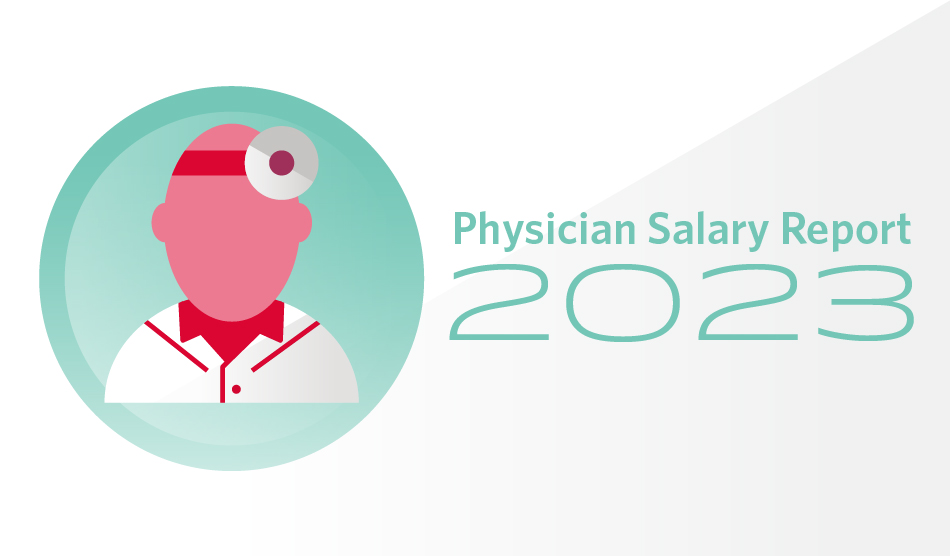The latest physician compensation report from Medscape reveals how physicians feel about their pay and jobs in 2023. The good news is that physician salary — including compensation for self-employed physicians and doctors who work full-time locum tenens jobs — continues to rise for most specialties.
Average physician income
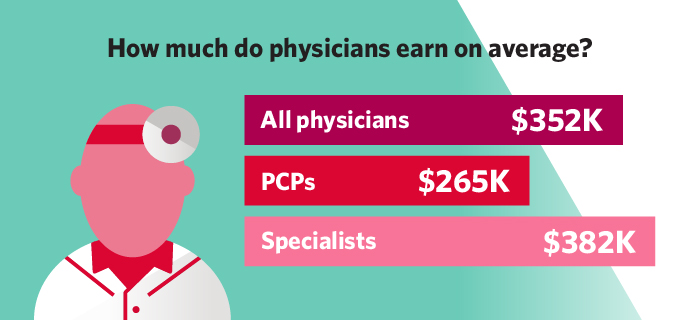
The average physician income was $352,000 vs. $339,000 in 2022. Most specialists also saw an uptick in compensation, landing at $382,000, up from $368,000 in 2022 and $344,000 in 2021. Primary care physicians saw an increase in salary as well, with an average income of $265,000 compared to $260,000 in 2022.
Income is expected to continue to rise across the board for all physicians.
As in prior years, plastic surgery ($619,000), orthopedics ($573,000), and cardiology ($507,000) remain the highest-paid specialties. These specialties have consistently topped this list for over 10 years. Other top-earning specialties include urology ($506,000), gastroenterology ($501,000), and radiology ($483,000).
Some specialties reported a greater increase in earnings, including oncology (+13%); gastroenterology (+11%); anesthesiology, radiology, critical care, and urology (+10%).
Which specialties decreased in earnings? Ophthalmology (-7%); emergency medicine (-6%); physical medicine and rehabilitation, nephrology, allergy, and immunology (-5%).
Women physicians’ salaries continue to trail men’s
Women physicians are branching into more specialties but also still earn less than men. On average, men make $286K and women physicians make $239K. This is a 19% pay gap, which is an improvement from 25% a few years ago.
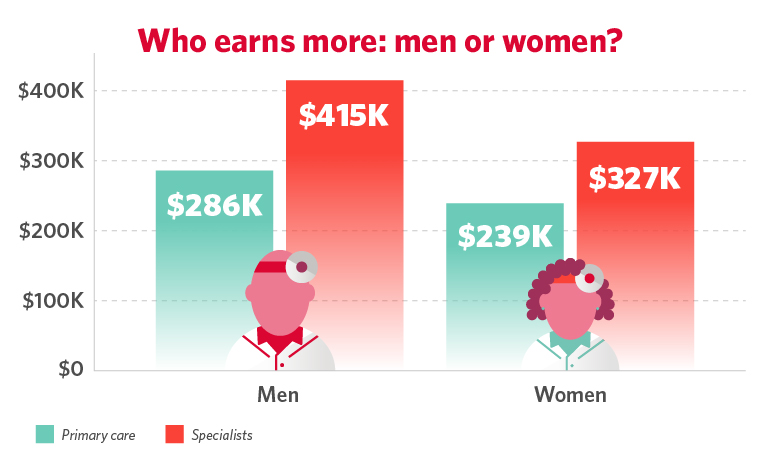
The percentage of women in specialties also continues to increase. Urology, for instance, increased from having 8% of female physicians to 13%, and plastic surgery increased from 16% to 19%. Primary care still has the largest percentage of female doctors.
Self-employed physicians earn more than employed physicians
As the report points out, self-employed physicians, which includes locum tenens physicians, earn more than employed physicians on average. Self-employed doctors earned an average of $374K vs. $344K for employed. Many physician specialties earn higher hourly pay working as locum physicians, according to pay ranges published for some of the largest specialties on locumstory.com.
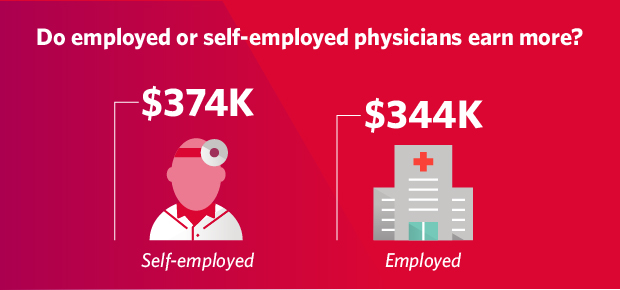
Twenty percent of physicians take on extra work to supplement their income. More than 11% moonlight. Many physicians, including those doing some locum tenens on the side, report they do this extra work to earn additional income.
LEARN MORE: 2024 State of Locum Tenens Report
Neurologist Dr. Kamlesh Jha, for instance, says she supplements her income working locum tenens in addition to her permanent position and also uses the occasional assignment to increase her experience. “I get some extra experience in procedures which I don’t see as often, and when you’re working extra, you’re looking at extra income.”
The highest and lowest-paying states for physicians
The top five states to work for higher salaries include Wisconsin ($379K), Indiana ($372K), Georgia ($363K), Connecticut ($362K), and Missouri ($361K). The lowest-compensating U.S. states are Maryland ($360K), Colorado ($327K), Virginia ($330K), Massachusetts ($331K), and Arizona ($334K).
Here’s a look at the top-earning states for locum tenens physicians, as reported by Locumstory.com.
Challenges physicians are facing
Any job comes with its challenges, and working as a doctor has especially unique and complex problems. In the survey, physicians said their biggest pain points were:
Too many rules and regulations 21%
Working long hours 16%
Dealing with difficult patients 13%
Working with an EHR system 13%
Worrying about getting sued 7%
So what keeps them in their field and provides satisfaction? Physicians said the most rewarding parts of their jobs were being good at it (30%), their relationships with patients (24%), and knowing they’re making the world a better place (19%).
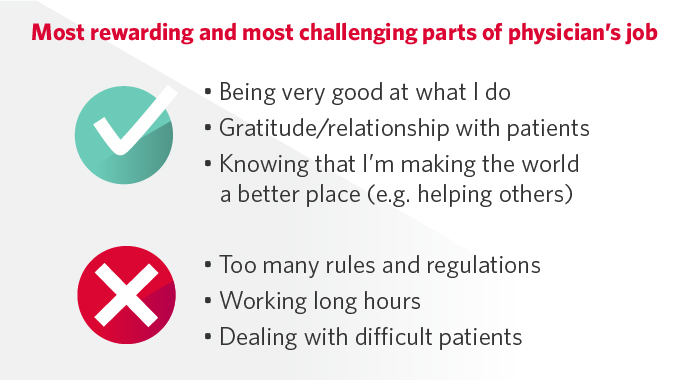
One way doctors are addressing their pain points is by turning to locum tenens, which reduces the administrative burden and provides a better work/life balance.
Dr. Jenny Martino, a critical care physician, says that working locum tenens has helped her focus more on patient care. “I got sick of the politics in American medicine, and that’s one thing I like about being a locum — I don’t have to go to meetings or get involved in the politics. I go to a hospital; I take care of patients. Locums is much simpler, and it also allows me to do a lot of international missions that I like.”
Dr. Melissa Macaraeg, a pediatrician, worked locums for the flexibility and to reduce her feelings of burnout. “There’s a joke that, ‘Per diem is freedom,’ and I like the freedom,” she says. “I was just really tired after residency, a little burned out,” she adds.
How physician specialties compare in administrative burden
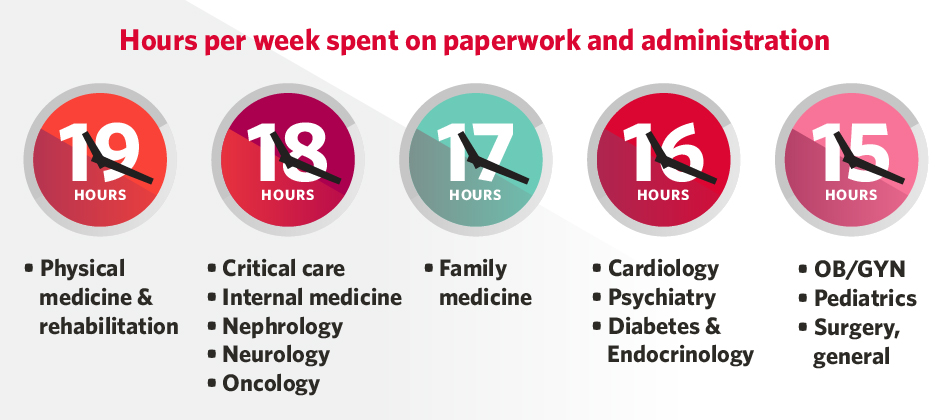
Some physician specialties spend more time than others on paperwork and administrative duties, adding up to nearly half of the work week. For instance, physical medicine and rehab doctors spend the most time on paperwork (19 hours), followed by critical care physicians, internists, nephrologists, neurologists, and oncologists, who all spend an average of 18 hours a week on paperwork and administrative duties. The specialty spending the least amount of time on paperwork and administration is anesthesiology at nine hours a week.
Dr. Gregory Kloehn, an interventional cardiologist, adds that locums can provide more downtime even while on assignment. “If you work locums, you’re not typically taxed as much in terms of your time. You roughly have a 9 – 5 presence. It’s sort of a more relaxed atmosphere which I think you could really see a benefit for later in your career.”
Advanced practice providers are physicians’ biggest competitors
Competition appears to be heating up, especially from advanced practice providers according to the report. In the prior year’s report, 67% of physicians said they were not affected by competition from non-doctors. This year, 63% say they are facing more competition.
Physicians’ biggest competitors are nonphysician practitioners like physician assistants, nurse partitioners, naturopaths, and chiropractors. Next are “minute clinics” like Walgreens and CVS, as well as insurers doing telemedicine.
Many locum physicians satisfied with locum tenens compensation
Many locum physicians say they earn as much or more than their counterparts in permanent employed positions, which tends to alleviate the feelings of being unfairly compensated for their time while reducing administrative burden and increasing schedule flexibility.
Urologist Dr. Theodore Ning wanted a way to work less while earning nearly as much as he had during his 20 years in private practice. “I was age 50 when I said, ‘There’s something else I have to do.’ I did 84 days out of the year that I was working.” The other parts of the year he dedicated himself to training residents and non-profit work.
Dr. Gary Trewick, an internal medicine physician, says he initially started working full-time locum tenens to pay down his loans after his residency. The plan was to work on that and then settle into a full-time position. “But it looks like there are more benefits to doing locums, including higher pay, so I may never sign a regular W-2 contract again.” The higher pay “opens up a lot of opportunities for traveling, just doing things I enjoy and helping others.”
Interested in learning more about working locum tenens? Give us a call or view today’s locum tenens physician job opportunities.

